Those who have at least once had a chance to see a room catharanthus certainly want to decorate their home with it. The fact is that this neat bush, decorated with many beautiful flowers, cannot leave anyone indifferent. The name of such a plant, translated from Greek, means "clear, pure or flawless flower."
This plant is quite widespread in indoor culture. Most growers are sure that the catharanthus is the king of indoor flowering shrubs. The fact is that it is distinguished by its undemanding care, but this plant blooms almost throughout the year.
Content
Features of the catharanthus
The flowering plant Catharanthus is a member of the Apocynaceae family. This genus is represented by evergreen shrubs and herbaceous plants. Such a plant can be found in areas with a tropical climate, for example, on the territory of Java, Indochina, Cuba, Africa, Indonesia, etc. Scientists have not yet figured out where the catharanthus comes from, but some experts believe that its homeland is Madagascar, where it is widespread most widely. On this island there are 7 or 8 species of catharanthus.
Under natural conditions, such a plant can reach a height of 150 cm. In this case, indoor catharanthus, as a rule, does not exceed 60 cm. In indoor culture, it began to grow from the second half of the 18th century. For many years, experts thought that this plant is a kind of pink periwinkle, and it was not isolated as a separate genus. These plants are very similar to each other, and both are part of the Kutrovy family. However, in 1937, after lengthy disputes, it was decided that the pink catharanthus (Catharanthus roseus) should be considered an evergreen semi-shrub perennial and separated into a separate genus of Catharanthus.
In fact, the catharanthus is a perennial, but at home it is most often cultivated as an annual plant. In indoor conditions, such a plant, as a rule, reaches no more than 0.5–0.6 m in height. In the upper part, fleshy and erect shoots branch, and over time their lignification is observed.The root system of this shrub is pivotal and quite powerful. In depth, the central root is capable of reaching from 0.2 to 0.3 m, it has a large number of lateral adventitious roots, which have a specific, rather sharp aroma. Young roots have no root hairs. The length of the oblong sheet plates is about 70 mm, they are pointed both from below and from above.
The bare, shiny foliage is painted in a dark green shade, and its central vein is decorated with white. The flowering bush is completely covered with a large number of wheel-shaped flowers. In diameter, the flowers of the correct shape can reach from 30 to 50 mm. They consist of 5 petals and a flat corolla, with thyroid hairs covering its pharynx. In the middle of each flower there is an eyelet, which is painted in a rich contrasting color shade. Today there are hybrids, the color of the flowers in which is orange, violet-blue, white or pale lilac. Outwardly, the flowers of this plant and phlox are very similar to each other. However, in the catharanthus, they are solitary, while in phlox flowers are part of the inflorescences. However, during the period of intense flowering, which begins in May and ends in October, a huge number of single flowers appear on the bush, they cover it with a lush cap. The plant stops blooming after the cold comes. At the end of flowering, fruits are formed on the bush, which are a crescent-shaped double leaf. There are about ten elongated seeds inside the fruit.
Healing properties
Catharanthus is a very spectacular plant, but it is appreciated not only for this. The fact is that it has healing properties. On the territory of Indonesia and Madagascar, such a shrub was used by healers and healers for the treatment of coughs, diabetes mellitus and a variety of tumors. The green parts of the bush include about sixty biologically active alkaloids. Currently, scientists have proven that this plant contains substances that help reduce the amount of sugar in the blood. Also, the alkaloids vincristine and vinblastine were isolated from catharanthus, which served as the basis for the manufacture of drugs intended to fight cancer. These drugs are used in hospitals today.
The stems and foliage of such a shrub is used in folk medicine for the preparation of various decoctions and infusions that are used to treat:
- polyp, fibroids, prostate adenomas;
- broncho-pulmonary diseases;
- trophic ulcers and wounds that heal poorly;
- diseases of the gums and teeth;
- diabetes mellitus and hypertension.
If you decide to use catharanthus for treatment, then remember that all its parts contain poisonous substances. That is why, without a certain experience and knowledge, it is extremely undesirable to prepare any medicinal products from this plant on your own! Otherwise, due to self-prepared medication, an allergic reaction may develop, serious side effects may appear, or burns may form. Products made from catharanthus have contraindications. It is recommended to use such funds only on the advice of the attending doctor and under his supervision.
Caring for the catharanthus at home
In order for the indoor catharanthus to please you with its appearance and bloom profusely, it must be looked after correctly. These rules are quite simple, but they must be followed. The main thing is to remember when working with this plant that all its parts contain poison. Therefore, before you start working with it, do not forget to wear rubberized gloves, then you will be able to avoid poisoning or the development of an allergic reaction.
Watering and humidity
This plant is distinguished by its moisture-loving nature. In order for its flowering to be lush, it must be in conditions of high humidity both in the air and in the soil mixture in the pot.Such a plant reacts negatively to dry air. Therefore, if the room humidity level is less than 60 percent, then the air around the plant must be regularly humidified from a spray bottle, and the bush itself must be sprayed very carefully. The foliage of the catharanthus can be moistened with a spray bottle, and the flowers are highly discouraged! To increase the level of humidity in the room, an open vessel with water is installed near the bush, and wet pebbles or expanded clay are poured into the pallet.
Do not forget to water such a plant systematically. Do not under any circumstances allow its root system to dry out. If watering is excessively rare or scarce, then the catharanthus will signal this with foliage, which will begin to curl. If you notice this in time and water the bush, then the foliage will return to normal quite quickly. However, when watering, it should be taken into account that water should not stagnate either in the substrate or in the pan. Try to choose a watering regime so that the soil in the pot is slightly damp all the time. Moisten the substrate in the pot only when its top layer dries out 20-30 mm in depth. If you want to grow catharanthus as a perennial, then in the fall and winter it is provided with more scarce and less watering. In the event that the humidity level in the room is low all the time, then moisten the foliage of the plant with a spray bottle regularly at any time of the year.
Illumination
Catharanthus needs diffused light. That is why it is recommended to choose western and eastern windows for its cultivation. Also, the bush can be placed on the south window, but in this case it will have to be protected from the scorching rays of the sun at noon. A pot with a bush can also be placed not on the windowsill. It develops and grows normally in a slightly shaded place and looks spectacular on a shelf that is illuminated by the diffused rays of the sun. If the catharanthus is warm in winter, then it will also need a large amount of diffused light. If he does not have enough light, then this will have an extremely negative effect on his decorative effect, since his shoots will begin to actively stretch out. If there is not enough sunlight, then provide the plant with additional fluorescent lighting.
Temperature regime
Indoor catharanthus grows best in spring and summer at temperatures from 20 to 25 degrees. When a perennial plant is wintering, it is removed to a cool place where the air temperature should be about 15 degrees. In no case do not keep the bush near working heating devices at this time. He winters well on an insulated loggia. But remember that the catharanthus cannot be in the cold. If it stays at temperatures below 10 degrees for a long time, it may die. If you decide to throw out the bush in the autumn immediately after it fades, then keep it in a warm place. In this case, it will bloom long and luxuriantly.
In the warm season, the bush can be moved outside. In spring, after the air outside warms up to 18 degrees and above, the bush can be transferred to the veranda or balcony. For a flower, choose a place that will have reliable protection from drafts, precipitation and direct sunlight. In August or September, as soon as it starts to get colder, it is recommended to transfer the plant to the house. It will still bloom in indoor conditions until October.
Substrate
To grow such a flower, it is recommended to use a light, loose substrate, saturated with nutrients. If you wish, you can purchase a soil mixture in a specialized store, intended for indoor flowering plants, for example, geraniums. You can do it yourself, for this, combine the sod and leafy soil. Mix the finished soil mixture with a small amount of coarse river sand and peat.
Top dressing
In order to achieve lush and long-lasting flowering, the catharanthus should be fed regularly and with sufficient fertilizer.If you cultivate this plant as an annual, then its feeding is carried out systematically 1 time in 7 days. Liquid fertilizer for indoor flowering plants must be diluted with the water used for irrigation. For example, you can use liquid fertilizer for indoor roses. You should adhere to the dosage indicated on the package, do not overfeed the catharanthus.
If you decide to grow the catharanthus as a perennial plant, then you should save its strength. That is why feeding in this case during the flowering period is carried out 2 times less often, or rather, 1 time in 15 days. In this case, the fertilizer dosage should be reduced by half. When flowering ends, all feeding should be stopped, they are not carried out from October to February.
Pot selection
When choosing a suitable container, it should be borne in mind that this flower is a fast-growing one. If you choose a small pot for planting, then the root system of the bush will soon fill it and it will become very crowded. In this regard, the choice should be stopped on a large container in which the bush can grow throughout the year. The root system of such a plant is well developed and can reach 0.2–0.35 m in length. This must be taken into account when choosing a flower pot. Do not forget to make a thick drainage layer at its bottom (from 30 to 40 mm), for this you can take pebbles, expanded clay or other material suitable for this. After that, cover it with a layer of substrate, which is recommended to be combined with a small amount of humus, which will increase its fertility.
Catharanthus are transplanted every year, and for this they use a container, which should be 30-50 mm larger than the old pot in diameter.
Pruning
Since this flower is fast growing, it must be cut off. If the catharanthus is grown as a perennial, then after wintering all the elongated stems are shortened by 1/3. It is also necessary to cut off all dry and injured branches, at the same time formative pruning is carried out. This procedure is carried out in early spring, it will help rejuvenate the bush.
In order for the plant to have a neat and lush crown, the tops of the stems of a young bush should be regularly pinched. Thanks to this, the shoots will stop stretching, instead, the active growth of the side branches will begin, thanks to which the crown will become more magnificent and more spectacular. During the flowering period, the decorativeness of this plant should be maintained constantly. To do this, promptly remove wilted flowers and yellow foliage, which is located at the bottom of the stems.
Transplant catharanthus
The shrub grown as a perennial needs regular transplants, which are carried out every year in early spring (in March). After transplanting, the bush is transferred to a warm and well-lit place. Inspect the bush and prune it.
It is necessary to transplant the bush carefully, using the transshipment method for this, make sure that the earthen lump on the roots does not collapse. Try not to damage the root system. You need to fill the voids in the new pot with the same soil mixture that was used to plant the bush last year. If you use a completely different soil mixture for this, this can lead to a lack of flowering. The substrate should be used slightly acidic or neutral. Do not forget about this, so it is best to use the same soil mixture all the time, for example, for flowering geraniums.
It may turn out that you have to transplant the catharanthus not 1, but 2 times a year. If, during the period of intensive growth, flowers fly around and yellowing of the lower leaf plates is observed, then most likely the roots are already very cramped in the pot. Look at the holes on the bottom of the container, if the roots are cramped, then they will look out of them. In this case, the plant needs to be transplanted very urgently, and take a larger flower pot. To make the bush easier to pull out, it is watered before transplanting.If the container is made of plastic, it will most likely need to be broken or cut, but be extremely careful not to damage the root system. Otherwise, flowering will stop.


Watch this video on YouTube
Reproduction methods
With good and proper care, the catharanthus will bloom profusely and retain its decorative effect for a long time. Experts do not advise growing one bush for more than 3 years. The fact is that an overgrowth is observed in a bush older than three years: the stems become clumsy, and the flowers become smaller. As a result, the bush loses its decorative effect. That is why after the plant reaches three years of age, it is replaced with a new one.
After the lush flowering is over, the bush weakens greatly, and it will take a lot of effort on the part of the grower for it to bloom again next season. That is why this plant is most often grown as an annual. When the bush fades, it is simply thrown away. The fact is that it is much easier to root a stalk or stem than to care for a bush in the winter. The new bush will get stronger by spring, grow up and will be ready to please you with its spectacular flowering. For reproduction of such a plant, 3 methods are used: the seed method, division of the bush and cuttings.
Growing from seeds
You can buy seed material of such a plant in a specialized store. They do not collect their own seeds from their bush, since they do not have time to ripen during the growing season. They are able to mature only in natural conditions in nature. If you do decide to collect seed from your bush, then you will have to wait a long time. The catharanthus will have to be grown during the autumn-winter period, while providing it with the most favorable conditions similar to natural ones: humidity and air temperature should be optimal and constant, and a large amount of light will also be required. Only at the beginning of spring will the seed material ripen.
Sowing seeds can be done at any time of the year. However, remember that a young bush will begin to bloom only 2-3 months after germination. In this regard, it is much more practical and convenient to carry out sowing in early spring. To begin with, the seed is treated with a solution of potassium manganese, and then it is treated with epin. For sowing, a small container is used, which is filled with fertile soil mixture, while the seeds should be buried no more than 10 mm. Water the crops, for this they are moistened from a spray bottle with well-settled water, the temperature of which should be slightly higher than room temperature. The container with crops on top must be closed. Any not very large container is suitable for sowing, which should be covered from above with film or glass. Crops are harvested in a warm and dark place. The first seedlings can be seen in 7-15 days. After that, the container should be transferred to a bright place. The optimum air temperature is 23-26 degrees. Do not forget to regularly air the crops: once a day, morning time is best for this. After the seedlings appear, they do not grow for 30 days, during which time they build up the root system. A pick in individual pots is carried out after 3 or 4 true leaf plates grow on the bushes. Remember that mature seedlings grow very quickly, so a large pot is used to plant them. In this case, you do not have to transplant the overgrown flowering bush.
A suitable potting soil should be used for planting a young plant. For this, a substrate consisting of humus, coarse sand, peat and soddy soil (1: 1: 1: 1) is well suited. When buying a ready-made soil mixture, choose one that is suitable for flowering indoor plants.
Propagation by cuttings
First you need to prepare the cuttings, for this, cut off the upper parts of the stems, which should be green. You can root the stalk in a soil mixture or in a vessel with water.The water should be boiled or well settled, while the drug that stimulates the growth of roots should be dissolved in it. The container with the handle is placed in a well-lit and warm place. Water is added to the glass, if necessary, the roots of the cutting should appear quite quickly. At the end of rooting, the cutting is planted in a suitable substrate. A young bush is looked after in the same way as an adult.
For rooting, cuttings can be planted in a moistened soil mixture, but they must be covered with a transparent cap on top. Water the cuttings only if necessary, but you need to air them regularly. After the stalk starts growing, the shelter can be removed. Remember that during rooting, the cutting may die, so several pieces are harvested at once. Harvesting and rooting of cuttings is recommended in early spring after an adult bush is pruned. However, catharanthus can be propagated in this way in the fall. Cuttings root best at temperatures between 22 and 25 degrees.


Watch this video on YouTube
Dividing the bush
When transplanting an adult overgrown bush in the spring, it can be divided into several parts. Depending on the size of the root system, the bush can be divided into 2-3 parts. Lift the plant out of the container and carefully remove any substrate from its root system. Examine the roots and divide the bush into a certain number of parts using a sterilized, very sharp instrument. Places of cuts must be sprinkled with coal powder. Each bush is planted in an individual container, observing all the rules listed above.
Wintering
If in the summer you transplant the indoor catharanthus in the open ground, then you should immediately think about how you will keep the plant in the cold season. The fact is that this flower cannot survive even a mild winter. In the first days of October, the bush must be carefully removed from the ground, shortening its stems by 2/3 of the length. Place the bush in a container that can accommodate its entire root system. Next, fill the pot to the top with a soil mixture consisting of earth and sand. After that, the flower is transferred to a room where the temperature is kept at 15 to 17 degrees. In this case, it will be better if you find such a place in the apartment. He will have to stand there until the onset of heat. There is no need to water the plant in winter. After the air temperature outside in the spring rises to 18 degrees and above, the bush can be planted out again.
Possible problems
If something is wrong with the catharanthus, then you can understand it by its appearance. It will definitely signal you with its appearance in the event that you take care of it incorrectly. Therefore, carefully monitor the condition of the plant, which will allow you to timely correct all existing care errors and save the flower.
Diseases
- It happens that small spots or dark bumps form on the front surface of the leaf plates... In this case, something that looks like abscesses appears on the seamy surface. Such symptoms indicate that your catharanthus is sick with leaf rust. Most often, the development of such a disease is facilitated by increased air humidity, as well as regular waterlogging of the soil. And it also happens that the plant is planted in a substrate that is infected with rust fungi or it is excessively heavy. In order to save the flower, it is treated with fungicidal preparations. After processing, the bush is recommended to be transplanted into fresh soil mixture.
- It also happens that the foliage becomes lethargic, turns yellow and flies... This can happen if the bush is standing on the window, and at the same time it is not protected from the scorching rays of the sun. In this case, the plant must be moved deeper into the room, or instead, it can be protected from the sun in the form of a light curtain or blinds.
- If the air in the room is excessively dry, then the tops of the leaf plates will begin to turn yellow.... Especially often this problem appears in winter, since the air during this period is overdried by operating heating devices. In this case, take a high pallet and fill it with wet expanded clay, also move the flower away from heating appliances. And you can also put an open vessel filled with water near it. If the bush has already bloomed, then its foliage can be moistened from a spray bottle, using well-settled water for this, the temperature of which should be close to room temperature. As a result of these actions, the level of humidity in the air will increase, and the plant will return to normal.
- It often happens that the lower leaf plates on the bush turn yellow and fly around... This is a completely natural process for this plant. Tear off all yellow leaves in time, and the bush will always look neat and beautiful.
- Poor flowering may be due to the fact that the room temperature is too low... Move the catharanthus to a well-lit and warm place, and you can solve this problem.
- Flowering stops and the foliage turns yellow... Inspect the pot: if roots stick out from its drainage holes at the bottom, then this means that the bush is very cramped in the old container and needs to be transplanted into a new, more spacious one. After a little time, the bush will return to normal and bloom again.
- But the buds of the catharanthus can fly around for various reasons: dry air, poor watering or insufficient light... If watering is too rare, then due to a lack of moisture, young foliage from the upper parts of the stems will begin to fall off the bush. It may also be due to the fact that he is cold or dark.
Pests
On such a plant, scabies, aphids and spider mites most often settle. They can get to your flower by moving from neighbors, through an open window from the street, or you can bring them yourself from a flower shop. In this regard, all flowers must be examined systematically.
If pests were found on the bush, then the first thing he needs to do is arrange a warm shower, which will wash off most of the individuals. After that, with a brush moistened with alcohol, try to remove those pests that remain. Then treat the foliage with a soap solution. If there are a lot of pests, then treat the bush with an insecticide solution (Aktellika, Aktara or Fitoverma). You need to spray the bush twice or three times with a break of 1-1.5 weeks. Before using the product, read the instructions on the package.
Types and varieties of catharanthus
All hybrids, as well as decorative series of catharanthus varieties, were created by breeders using pink catharanthus. These plants differ from each other in the color of the flowers and the height of the bush. The ones that are most popular will be described below.
Katarantus Aristocrat
In height, such a plant reaches about half a meter. Quite large flowers reach about 50 mm in diameter. They can be painted in a variety of shades from deep red to pure white. As a rule, in the center of the flower there is a peephole of a contrasting color. Such a catharanthus is cultivated both at home and in the garden, decorating the borders of paths and flower beds with it.
Katarantus Pacific
The height of a small compact bush varies from 25 to 30 centimeters, while its crown in diameter can reach 15 to 20 centimeters. This plant is undemanding to care for and it is distinguished by its early flowering. Large flowers are decorated in the center with a characteristic catharanthus eye, which stands out noticeably against the background of the petals. This variety has several varieties that differ in color of flowers:
- Burgundy - the flowers are painted in a bright wine shade and have a white eye;
- White - white flowers are decorated with a red eye;
- Epricot - the apricot shade of flowers has a red center;
- Ice Pink - pinkish flowers have a red center.
In the eighties of the twentieth century, breeders created a fairly large number of new varieties of catharanthus. Today, the following are popular:
Variety series Cooler (Culer)
It consists of low plants, characterized by strong branching, their height does not exceed 0.4 m. Large, rounded flowers reach up to 50 mm in diameter. In the middle they have a peephole of a contrasting bright color. This series includes the following varieties:
- Grape Cooler - Lavender-pink flowers have red eyes;
- Peppermint Cooler - white flowers adorn the eyes of a deep red color;
- Red Cooler - flowers of a red hue.
Variety series First Kiss (First Kiss, First kiss)
The height of compact bushes varies from 0.3 to 0.4 m, their crown is quite spectacular, and the flowers can be painted in 13 different shades. This variety series is the most titled and is most popular with flower growers. The fact is that during the competitions of flower growers in North America, representatives of this variety series received prestigious awards. For example, the violet-blue cultivar First Kiss Blueberry has received high awards in Canada and the United States.
Variety series Cascade
This series includes ampelous catharanthus. The short bushes are only about 15 centimeters high. Their long stems are flexible, and they either hang down or spread along the ground. In diameter, large flowers reach about 50 mm. The most popular varieties are:
- Katarantus ampelous Titan - the length of the lashes hanging down is about 0.75 m, against the background of dark green shiny foliage, rich red flowers stand out brightly, most often the variety is cultivated in pots;
- Catharanthus titan White - has snow-white flowers;
- Deep Rose - pink flowers;
- Bark Cascade Cherry - cherry blossoms;
- Bark Cascade Shelf Dot - the bush is decorated with white flowers;
- Bark Cascade Medjenta - flowers are painted in a burgundy-lilac shade.


Watch this video on YouTube

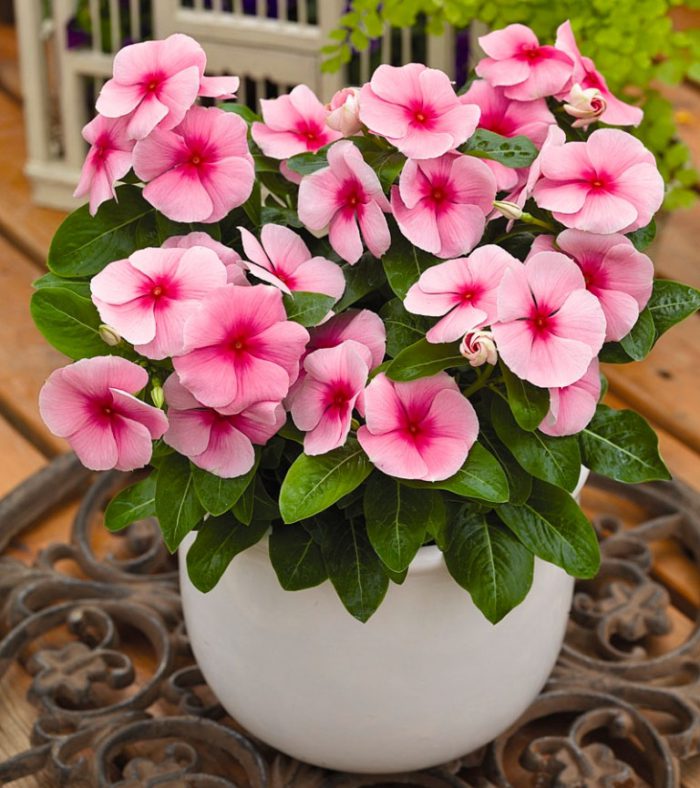
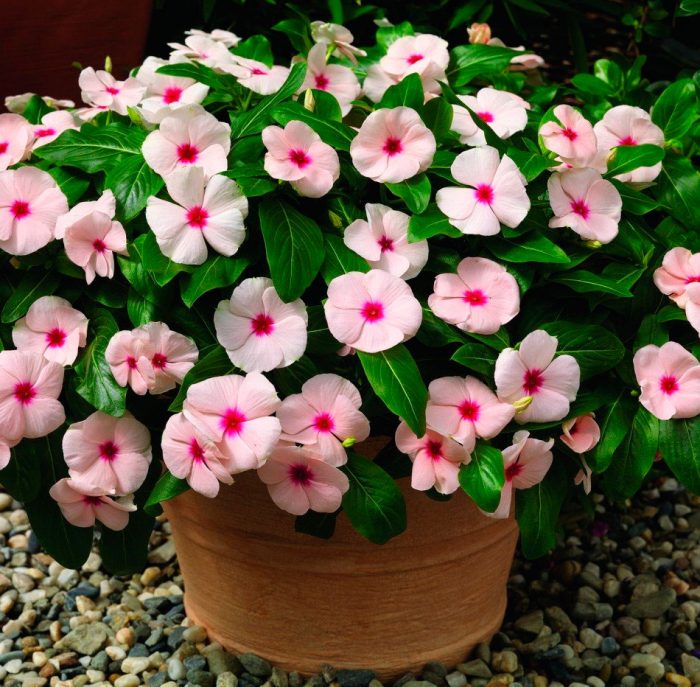
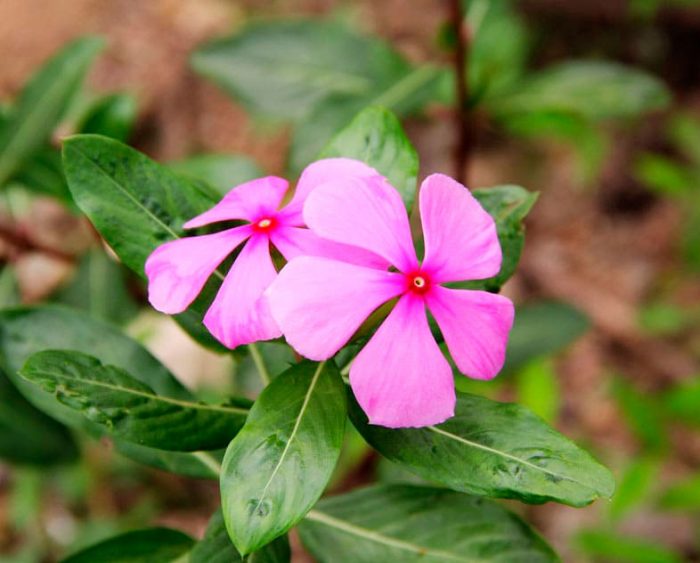
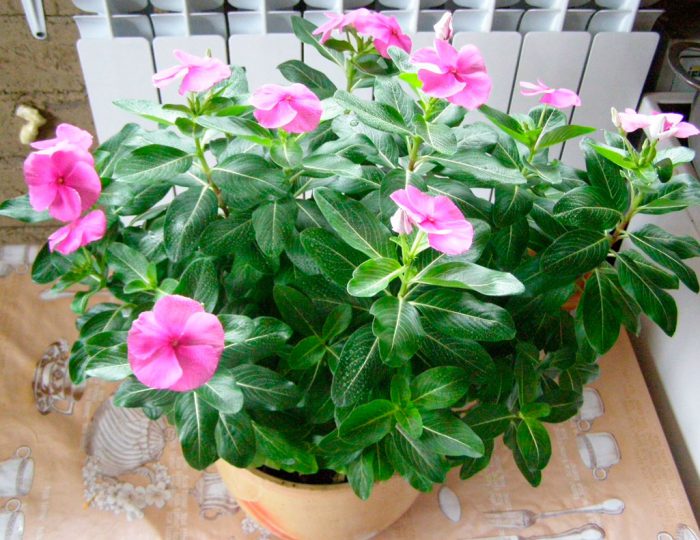



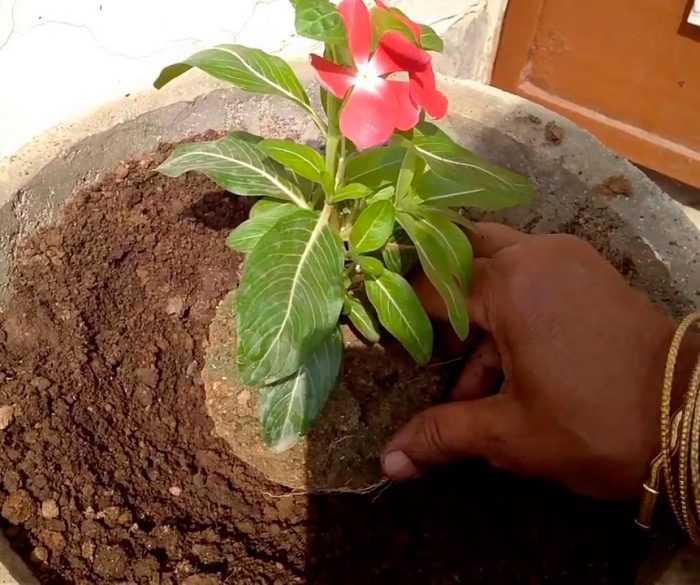
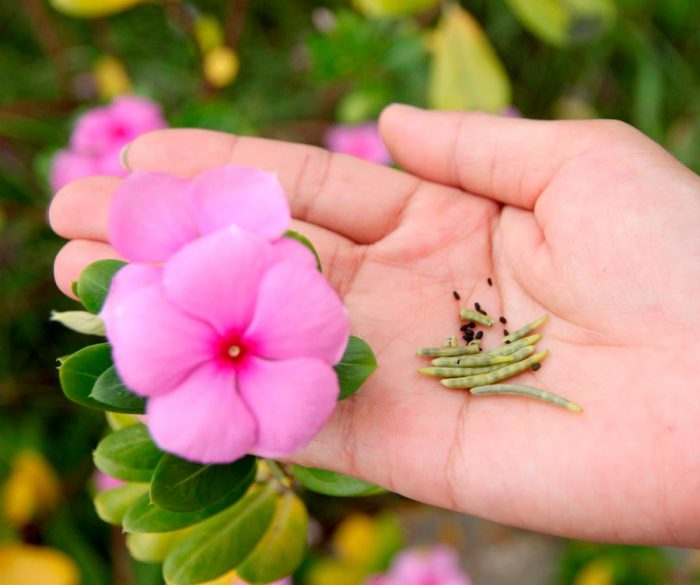
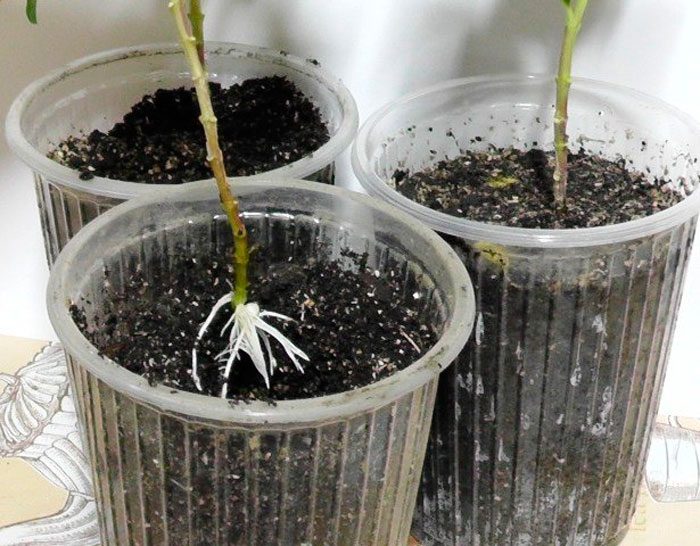

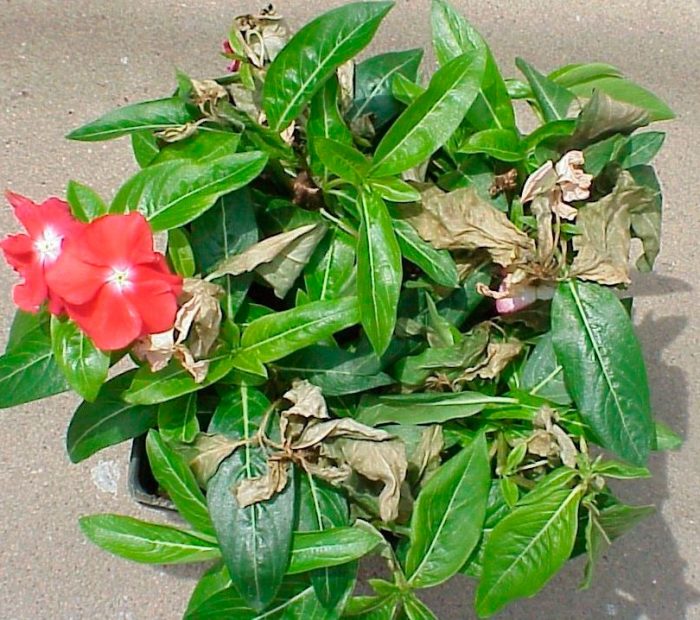
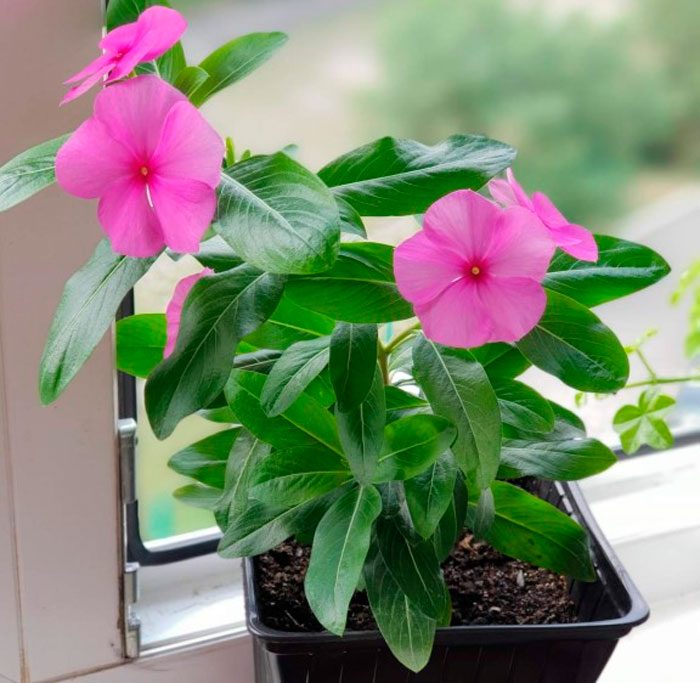

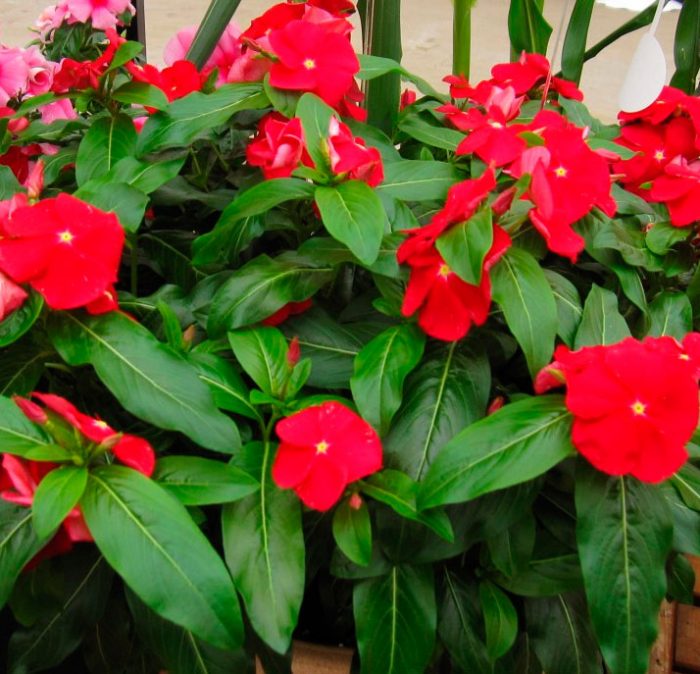

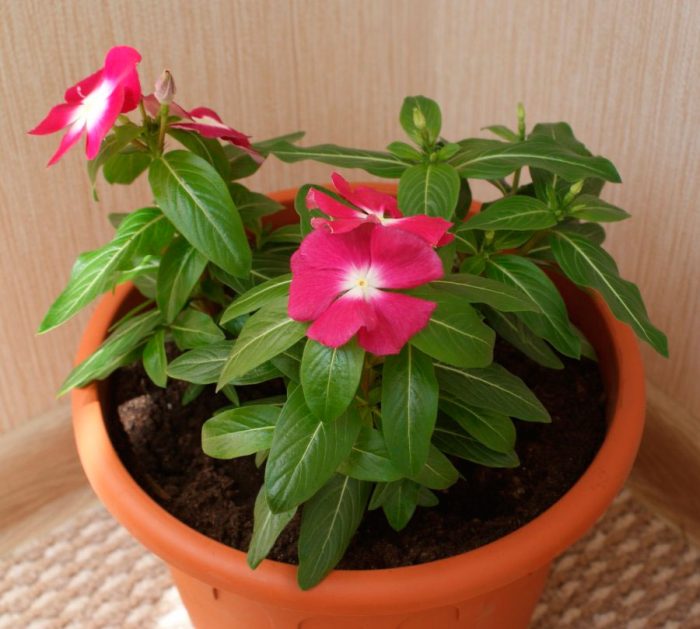











I have two types of catharanthus ... chapel and bush ... The color is red, pink and white. Only in three pots the direct sun does not take root well after dinner, but in Krasnodar it is hot ... I have a dacha there !!!! And in the shade it is cool and the leaf is beautiful dark green. You have to water it 2-3 times a day, the earth dries up from the heat. I brought it to Rostov for wintering for the first time, I want to keep it until spring ...
A wonderful article, but I disagree about the non-ripening of my own seeds. Last year she sowed Katarantus Burgundy for the first time. 7 seeds out of seven have sprung up, I gave 2 bushes. A very beautiful and absolutely unpretentious plant, only demanding for watering. From the middle of autumn, the bushes began to lose their decorative appearance, the lower branches became bare, the flowering decreased, seeds began to form in parallel and gradually the pods with seeds fell off, they constantly "sowed" my entire windowsill :)) Those seeds that fell into the pot immediately germinated. I decided not to save the plants. Collected seeds. Now the seeds are planted in mid-March in a greenhouse for 33 cells, 2 seeds per cell. Approximately 95-97% of the seeds rose. So grow and harvest seeds, even from one plant there are a lot of them.